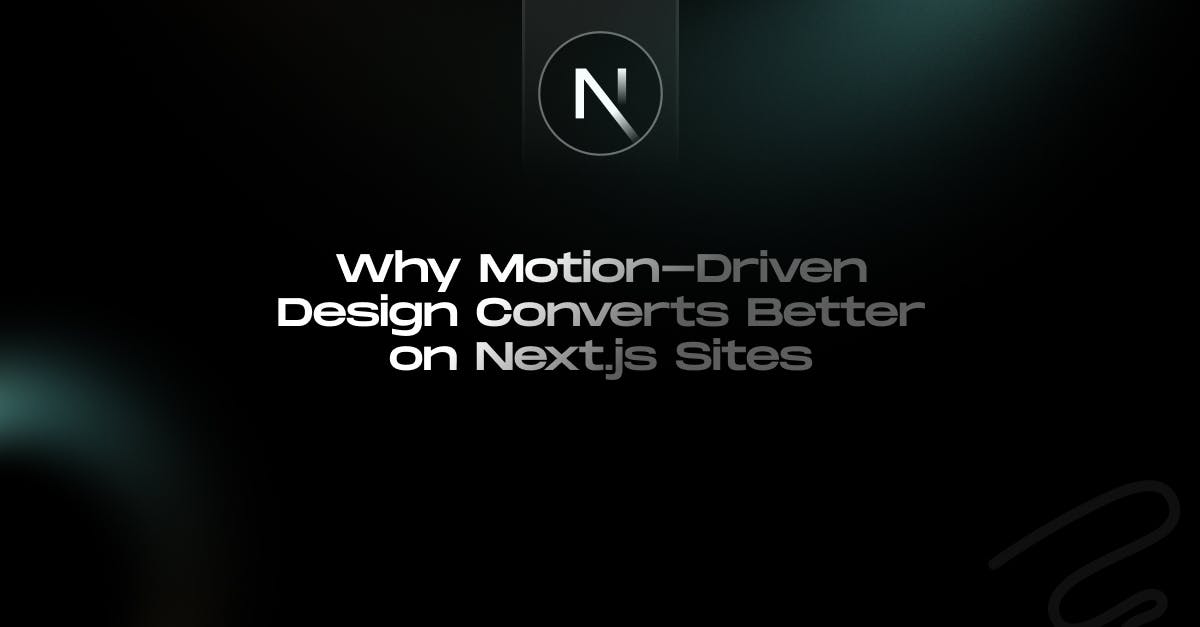September 28, 2025
Why Motion-Driven Design Converts Better on Next.js Sites

Md. Saad

Why do some websites instantly grab attention while others lose visitors within seconds?
The secret often lies in motion-driven design. In today’s digital landscape, a website is more than just a static page; it’s an interactive experience that can decide whether visitors bounce or convert. Motion-driven design uses purposeful animations, micro-interactions, and transitions to guide attention, simplify navigation, and build trust.
When paired with the speed, scalability, and SEO-friendly performance of Next.js, it becomes a powerful way to create fast, engaging, and conversion-focused websites. In this post, we’ll explore why motion-driven design matters, how it improves the user journey, and why Next.js is the perfect framework to bring these experiences to life.
Motion-Driven Design: What Is It?
Animations and transitions are used in motion-driven design as a useful component of the user experience rather than as ornamentation. Consider hovering buttons that scale gently.
- seamless page changes during navigation.
- content-revealing animations that are triggered by scroll.
- micro-interactions (such as a checkmark that shows up after a form is submitted) that validate user actions.
With performance in mind, the objective is to lead users, provide clarity, and foster joy.
1. Motion Captures Attention Instantly
A website's initial seconds are crucial. Users make their decisions to stay or go quickly. Important areas are naturally highlighted by motion-driven elements, like
- silently pulsing call-to-action buttons.
- Hero text that appears and disappears.
- As the user scrolls, featured goods or services become visible.
Users are kept interested by these micro-moments long enough to comprehend your message, which is the first step toward conversion.
2. Motion Enhances the User Journey
Motion aids users in understanding what's happening and isn't just for "looking cool." For instance:
- Animated transitions lessen the startling impact of abrupt content changes when navigating between pages in a Next.js website.
- Wait times appear shorter thanks to loading animations and progress indicators.
- Users can see precisely where to click or scroll next thanks to guided animations.
One of the main barriers to conversion is friction, which is lessened by this clarity.
3. Motion Encourages Interaction
Links and buttons that are static frequently disappear into the background. They come to life when you add a little motion. For instance:
- a signup button that, when hovered over, slightly expands.
- a pricing plan card that, when chosen, lifts forward.
- smooth-moving dropdown menus or interactive tooltips.
These interactions encourage clicks, lessen hesitancy, and give the experience a more responsive and human feel.
4. Motion Strengthens Brand Identity
Your website's user experience is just as much a part of your brand as its colour scheme and typeface. Personality is added by motion-driven design:
- A brand aimed at young people can feel enjoyable with playful animations.
- For corporate brands, seamless and understated transitions can enhance professionalism.
- Using motion consistently throughout your website increases memorability and trust.
Users are much more likely to convert when they have an emotional connection to your brand.
5. Motion Guides Users Toward Conversions
Intentional motion is the best kind. Motion should serve as a visual cue to the next step rather than overpowering users with effects. For instance:
- Form fields are highlighted when checking out.
- displaying discount codes through a fluid animation.
- Creating an animated progress bar to encourage users to finish the signup process.
Motion decreases drop-offs and encourages users to approach your conversion objectives by grabbing their attention at the appropriate times.
6. Why Next.js Is Perfect for Motion-Driven Design
Animations are only effective if the performance is stable. A slow, sluggish website will cause more harm than good. Next.js excels in this situation:
- Enhanced Performance: Next.js ensures seamless transitions with lightning-fast server-side rendering and routing.
- Smooth Integration with Motion Libraries: Developers can easily create production-ready, GPU-accelerated animations with @motion/react (formerly Framer Motion).
- SEO-Friendly Animations: Next.js was developed with SEO in mind, so you can use motion to improve user experience without compromising search engine rankings.
Motion-driven design and Next.js performance combine to produce quick and engaging experiences that are ideal for conversions.
Final Thoughts
Motion-driven design is no longer a “nice-to-have”; it’s a necessity for businesses that want to keep users engaged and convert more effectively. By combining purposeful animations, intuitive interactions, and seamless transitions with the performance power of Next.js, you can create a website that not only looks stunning but also delivers measurable results.
At StaticMania, we specialize in bringing these experiences to life. Our team of Next.js and motion design experts crafts websites that balance creativity, speed, and SEO performance. From micro-interactions that guide users to scroll-based effects that tell your brand story,we know how to use motion to boost conversions without sacrificing usability. If you’re ready to transform your website into a conversion-focused digital experience, StaticMania is here to help. Contact us today and let’s build a fast, engaging, and conversion-focused experience for your users.
FAQs: Motion-Driven Design in Next.js
Motion-driven design utilizes animations and transitions not only for decoration but also to enhance usability. Examples include hover effects, smooth page transitions, scroll animations, and micro-interactions that guide users and enhance engagement.
Motion grabs attention, highlights calls to action, reduces user friction, and provides visual feedback. These improvements keep visitors engaged, build trust, and encourage them to complete actions like signups, purchases, or form submissions.
Yes, Next.js is excellent for motion-driven design. It offers fast performance, smooth page transitions, SEO-friendly rendering, and integrates easily with animation libraries like Framer Motion (now Motion.dev).
Not if implemented correctly. Using lightweight libraries such as Motion.dev with Next.js ensures animations are GPU-accelerated and performance-optimized. Overuse or poorly coded effects can slow sites, so balance is key.
Examples include animated call-to-action buttons, progress bars in forms, scroll-triggered reveals for products, smooth modal transitions, and micro-interactions like checkmarks on successful form submissions.
StaticMania specializes in Next.js development and motion-driven design. Our team builds fast, SEO-friendly, and interactive websites using purposeful animations to increase conversions and improve user experience.

